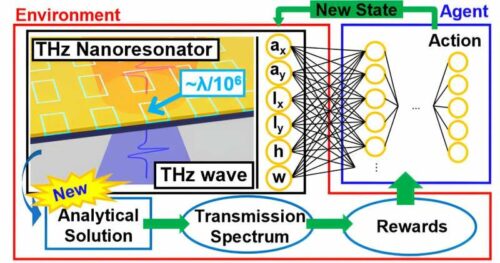Learn how this innovative approach combines AI and a deep understanding of physical phenomena to unlock exciting possibilities for the future of communication technology.

A team of researchers led by Professor Hyong-Ryeol Park from the Department of Physics at UNIST (Ulsan National Institute of Science and Technology) has unveiled a transformative technology capable of amplifying terahertz (THz) electromagnetic waves by an astonishing factor of over 30,000 times. This remarkable achievement made possible through the integration of artificial intelligence (AI) based on physical models, is poised to reshape the landscape of 6G communication frequencies.
The research team successfully tailored the THz nano-resonator for 6G communication deployment, employing cutting-edge optimisation techniques. Their findings have been published in the online edition of Nano Letters. By harnessing the power of AI guided by a physical theoretical model, the team has streamlined the design process of THz nano-resonators, previously a laborious task even with supercomputers, now rendered accessible on personal computers. This innovation has far-reaching implications for the advancement of communication technology.
Through a series of rigorous experiments involving THz electromagnetic wave transmission, the team assessed the efficacy of their newly devised nano-resonator. The results were nothing short of remarkable, with the electric field generated by the THz nano-resonator eclipsing that of conventional electromagnetic waves by more than 30,000 times. This achievement represents an extraordinary efficiency improvement of over 300% compared to previously reported THz nano-resonators. Traditionally, AI-based inverse design technology primarily focused on optical device structures within the visible or infrared spectra, which are only a fraction of the wavelength. However, applying this technology to the 6G communication frequency range (0.075–0.3 THz) posed significant challenges due to its minute scale, approximately one-millionth the size of the wavelength.
To surmount these challenges, the research team devised an ingenious approach by combining a novel THz nano-resonator with an AI-based inverse design method grounded in a physical theoretical model. This approach facilitated device optimisation in less than 40 hours, even on personal computers, in stark contrast to the previously required tens of hours for a single simulation or potentially hundreds of years for optimizing a single device.
The team pointed out its potential applications in ultra-precise detectors, ultra-small molecular detection sensors, and bolometer studies. Lee emphasized that the methodology employed in this study is not restricted to specific nanostructures and can be extended to various studies using physical theoretical models of different wavelengths or structures. While AI may appear to be the solution to all problems, comprehending physical phenomena remains crucial. This groundbreaking research opens up exciting possibilities for the future of communication technology, with 6G on the horizon.







